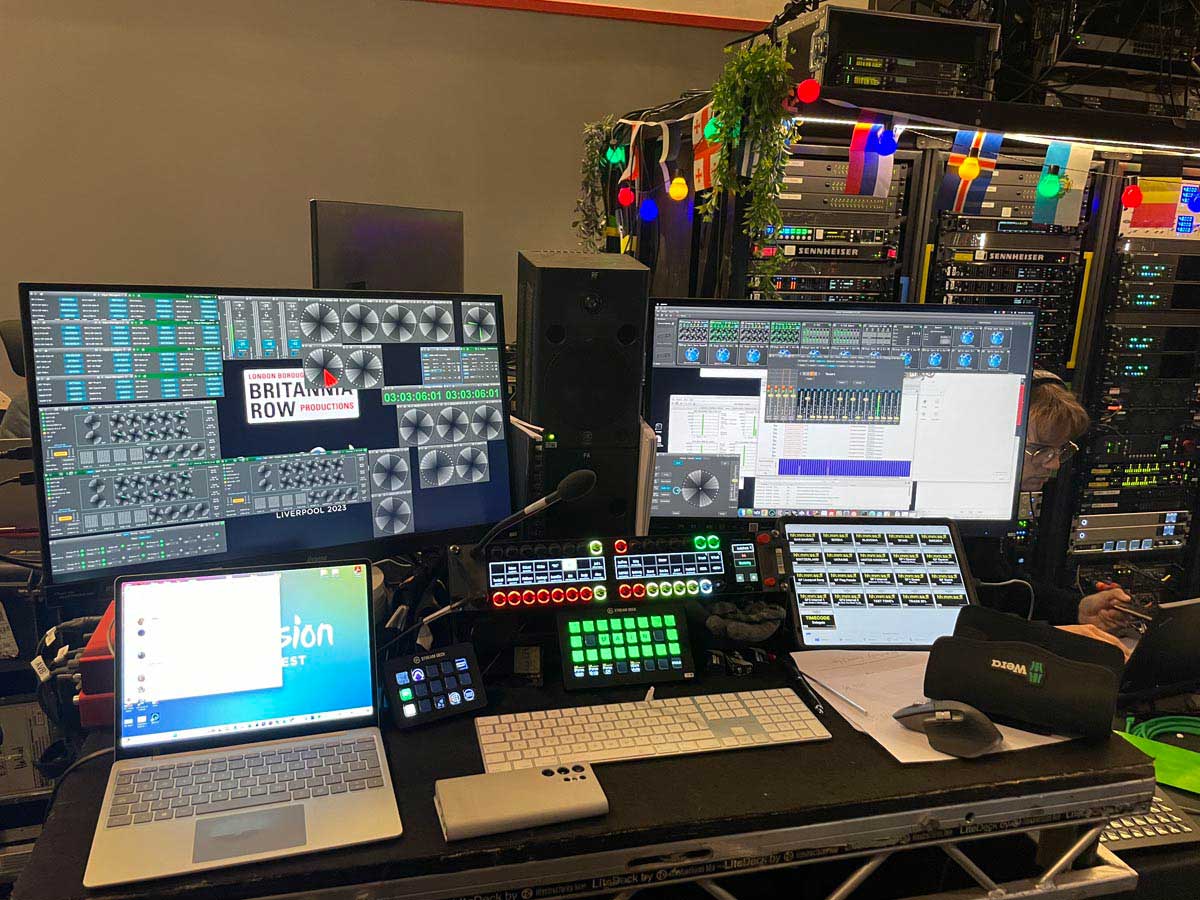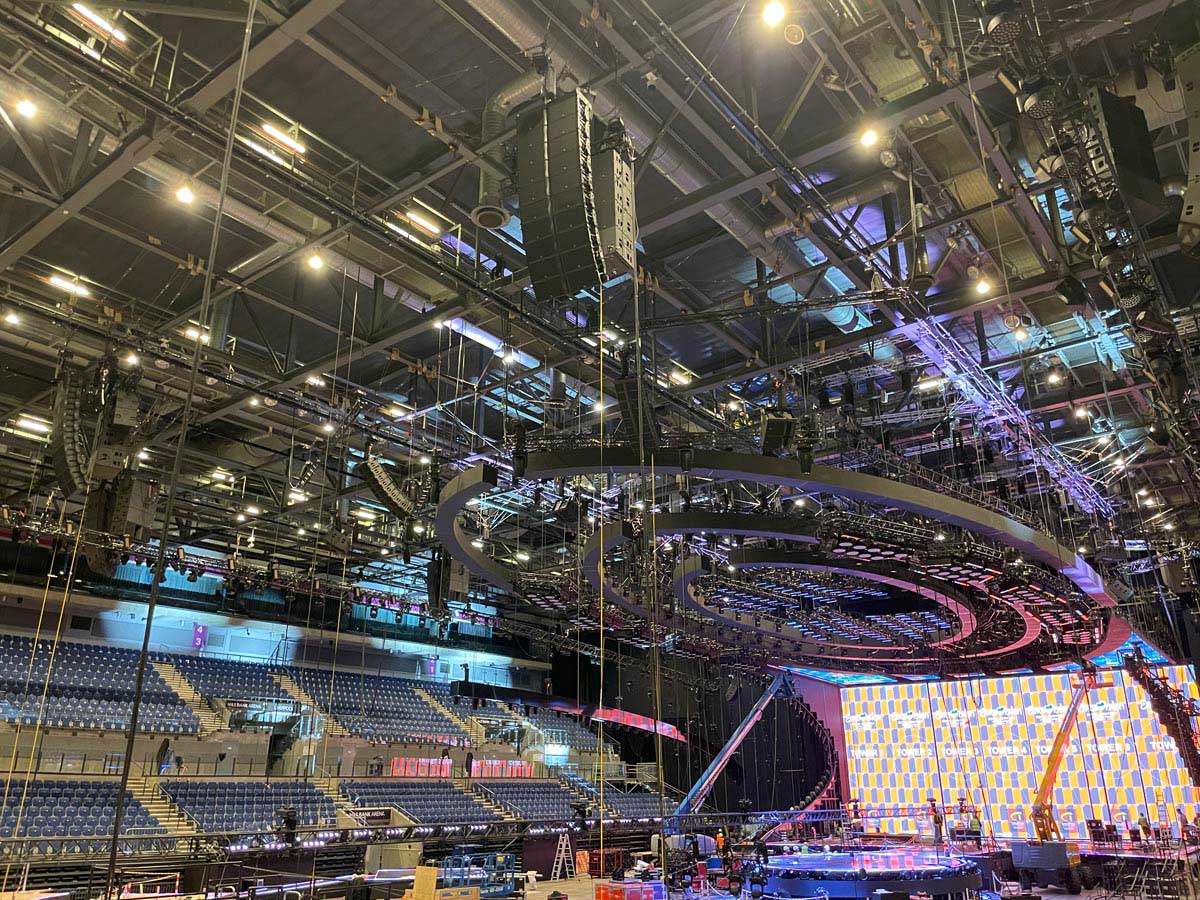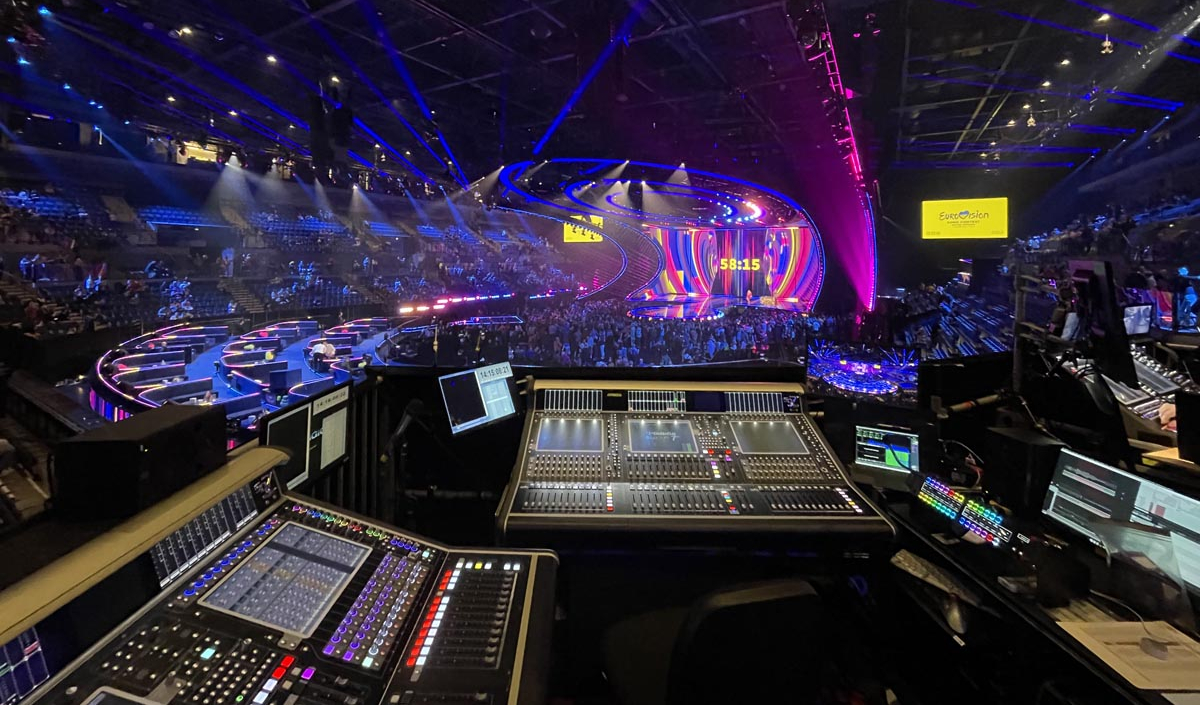
Britannia Row’s Josh Lloyd (Head of Engineering) discusses designing the audio distribution network for Eurovision 2023.
The final of the 67th Eurovision Song Contest was held at the Liverpool Arena on 13th May 2023. Love it or hate it, the kitsch extravaganza is one of the most popular globally televised music events, with this year’s show raking in approximately 160 million viewers worldwide.
Naturally the production is a huge operation, with each performance delivering a unique combination of lighting, visuals, choreography and a variety of props, with lightning-fast set changes required in between each track.
The audio infrastructure was supplied by Britannia Row Productions, a premium rental service that provides audio and tour support for artists like Harry Styles and the Foo Fighters, as well as other large televised events such as the Brit Awards and the MTV EMAs.
Based around a converged network involving huge numbers of channels, audio at Eurovision was distributed to multiple destinations – and with multiple layers of redundancy – supplying the playback rig, monitoring, PA and front of house, as well a fleet of OB trucks for the broadcast mix.
To find out more about what goes into the design of such a large-scale production, we sat down with Britannia Row’s Head of Engineering Josh Lloyd, who kindly gave us a behind the scenes look at the system he devised for Eurovision 2023.
The Sound of Eurovision 2023 with Josh Lloyd (Britannia Row)
See more videos at Synthax TV
About Josh Lloyd
“I’ve been fortunate enough to be involved in a variety of projects at Brit Row,” Josh tells us regarding his role.
“I started off in the warehouse on the shop floor, supporting jobs by prepping them and putting them together. Then I ended up out on the road crewing, fulfilling a number of different roles in the audio team. Developing my skills, whilst learning from my mentors and others at Brit Row. Until I find myself where I’m at today, designing for large shows and arena tours!
“Some of my proudest moments include working on the Queen’s Diamond and Platinum Jubilee celebrations, which taught me a lot about the nuts and bolts of designing and building a large distributed audio system.
“I’ve also done quite a lot of touring in my time, with past clients including Robbie Williams, Oasis, Peter Gabriel. So quite a wide variety of musical genres, and I’m really proud of my work with those guys as well.”
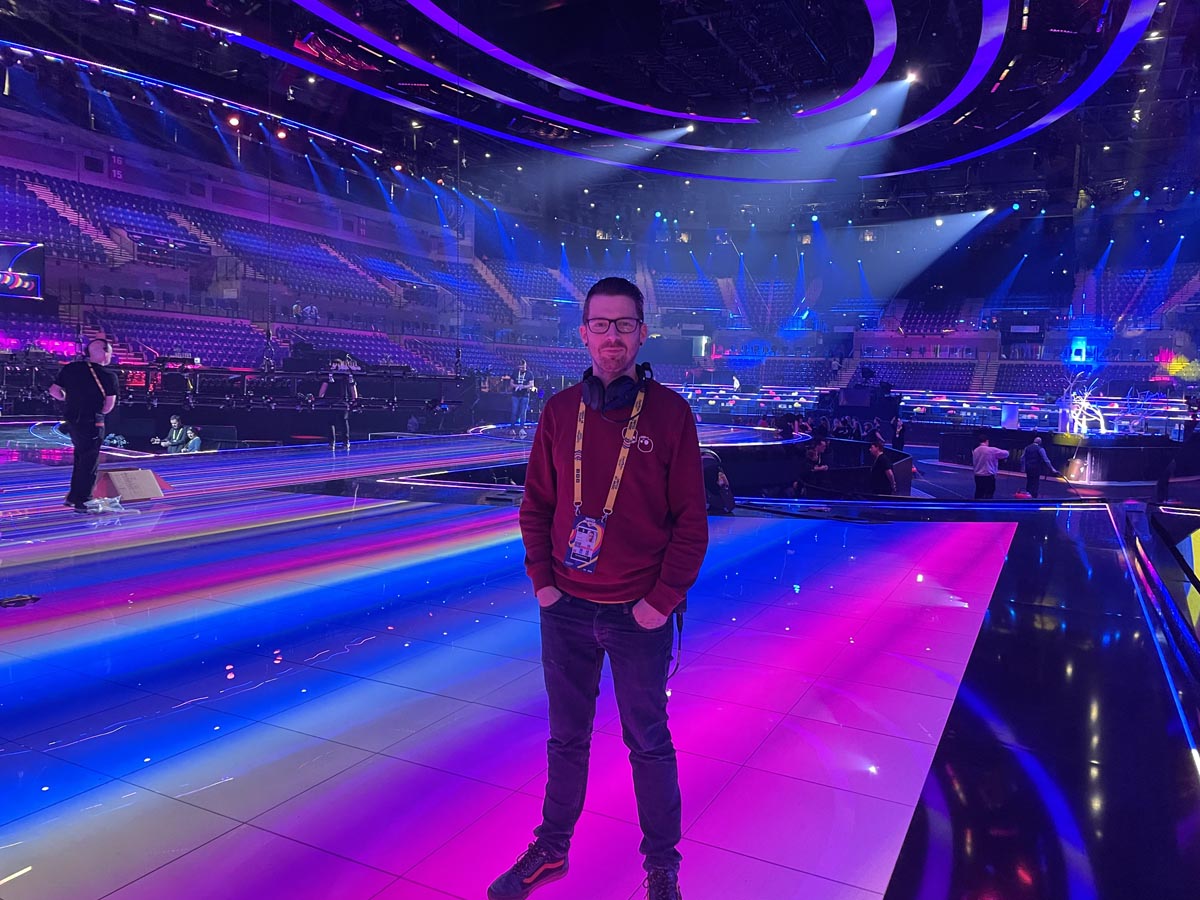 “For something like Eurovision, we’re usually quite involved with the show from its infancy. From the earliest design phase really, when the set design, lighting and all of the other elements are being brought together.
“For something like Eurovision, we’re usually quite involved with the show from its infancy. From the earliest design phase really, when the set design, lighting and all of the other elements are being brought together.
“Our aim is to deliver a system that works in tandem with the rest of the show – one that works sympathetically with other parts of the design, but without compromising the audio of course.
“After we’ve completed the PA design, which is quite an involved process these days, with the use of acoustic modelling software etc, we start to look at how the system all joins together.
“So that’s often where products from the likes of RME and DirectOut come into play. Finding tools that help us deliver what we need to achieve for a project, whilst also maintaining the audio quality that we’re passionate about.”
DirectOut at Eurovision
Bringing an event the size of Eurovision to life is obviously no small task, requiring meticulous planning during the build-up phase and the live show itself.
Rigorous rehearsals are followed by two days of semi-finals, before the four-hour, live televised finale on Saturday night – complete with Graham Norton’s famously sarcastic and tongue-in-cheek commentary.
“In terms of crew we had around 20 people just for the live side of the audio,” Josh explains. “We were on-site for around 7 weeks, installing the system and then rehearsing, and delivering a week’s worth of shows.”
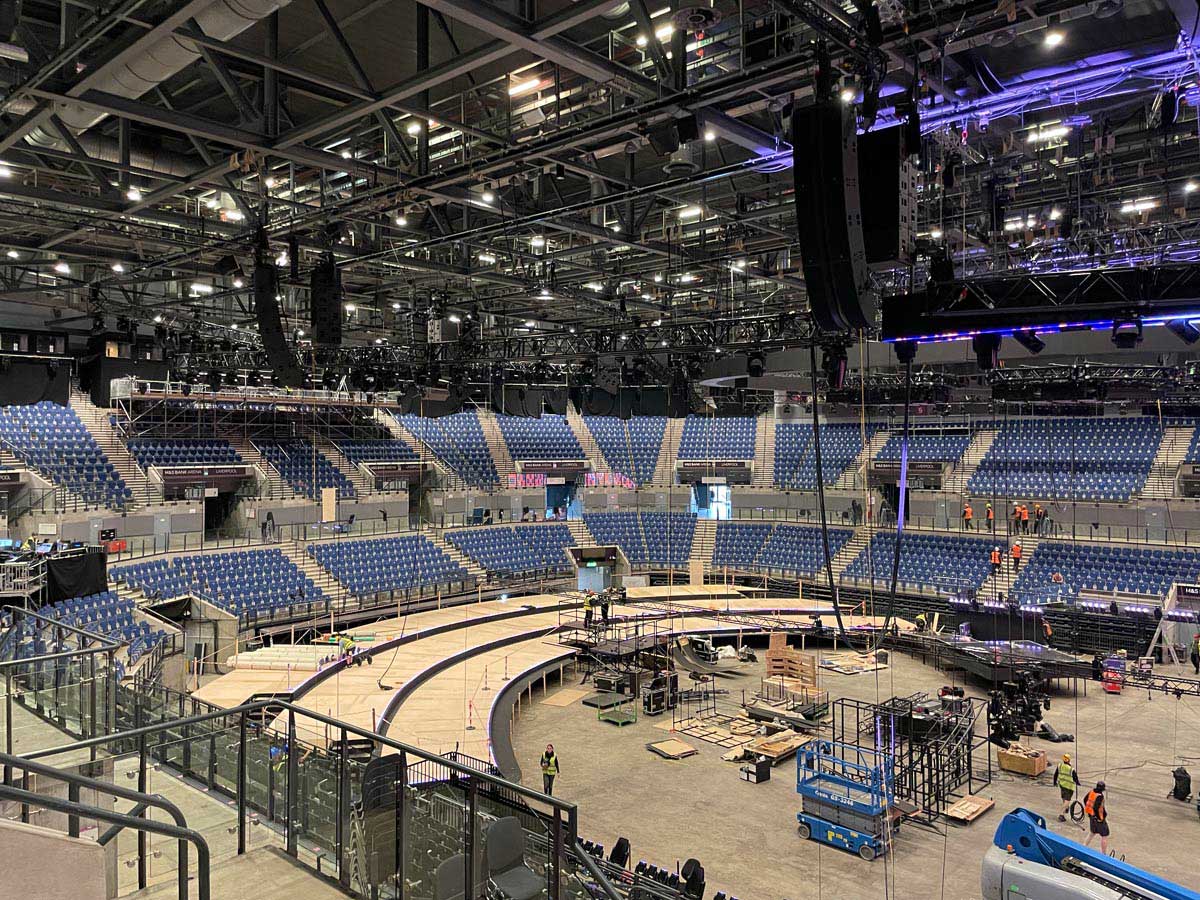
“The whole system was built around a fibre backbone, utilising a single converged network with multiple formats. Analogue, AES-3, MADI, Dante and AVB, as well as other formats like NDI video, RTP MIDI, plus file sharing and other control data. So a converged network is really key to a show like this.
“There were also multiple OBs. One providing the broadcast music mix, with another providing the presentation and overall show mix, and included things like the audience mics.
“And then a third OB truck that was essentially redundancy for the other two, providing a duplicate mix. So if one of the trucks was to go down, they could easily switch over to the backup.”
The audio system was designed around a number of devices from DirectOut – in particular the Prodigy.MP, which served as a central hub for the operation.
A powerful and flexible audio converter and processor, the Prodigy.MP was responsible for a range of tasks including AD/DA and format conversion, signal routing and monitoring, audio distribution, and sample rate conversion via DirectOut’s FastSRC – all of which could be conveniently managed from anywhere on the network using DirectOut’s GlobCon software.
“A big part of the brief for a show like Eurovision is the resilience and redundancy – you just cannot afford to have anything fail during the show,” Josh continues.
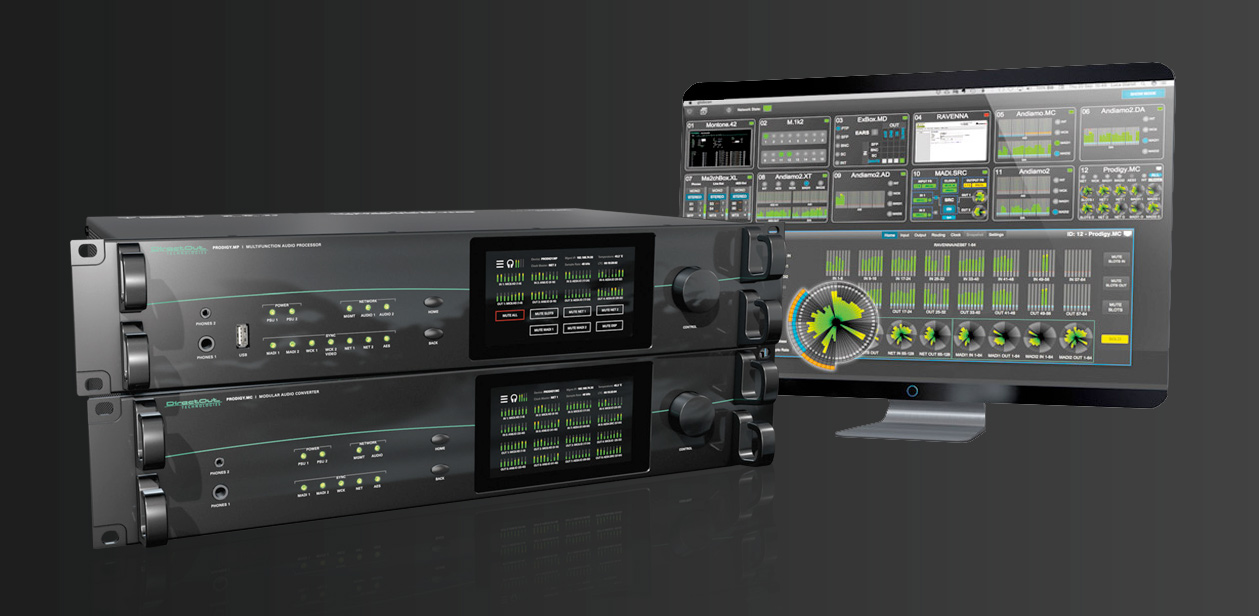
The DirectOut Prodigy Series with GlobCon control software
“DirectOut played a really large part in that delivery, with the core of the system based around four Prodigy.MPs. One for handling all of the playback and radio mics, and another handling all of the signal distribution to the loudspeaker system in the arena. Each of those is then backed up to a second Prodigy.MP for full redundancy, with switching via DirectOut’s M.1k2 processors.
“We had 64 channels of radios hitting the Prodigy itself. A lot of the radio mics natively support Dante, so that was how we were getting signal from them and distributing it in the digital domain.
“So we’re delivering Dante to some consoles, and MADI to other consoles within the arena, with Digico Quantum 7s providing both the monitor and front of house mixes.
“We actually had two at each end – so again a main and a backup – with the Quantum 7s taking MADI from the DirectOut M.1K2s, fed via the Prodigys.
“We then had a pair of Digico SD12s for all of the presentation mixes – this time fed via Dante from the Prodigys – as well as 16 MADI feeds supplying the OB trucks for the broadcast mix, including mains and backups.”
A system of this scale naturally presents a variety of challenges for the audio team, with a large channel count, multiple clock domains and a variety of formats to contend with.
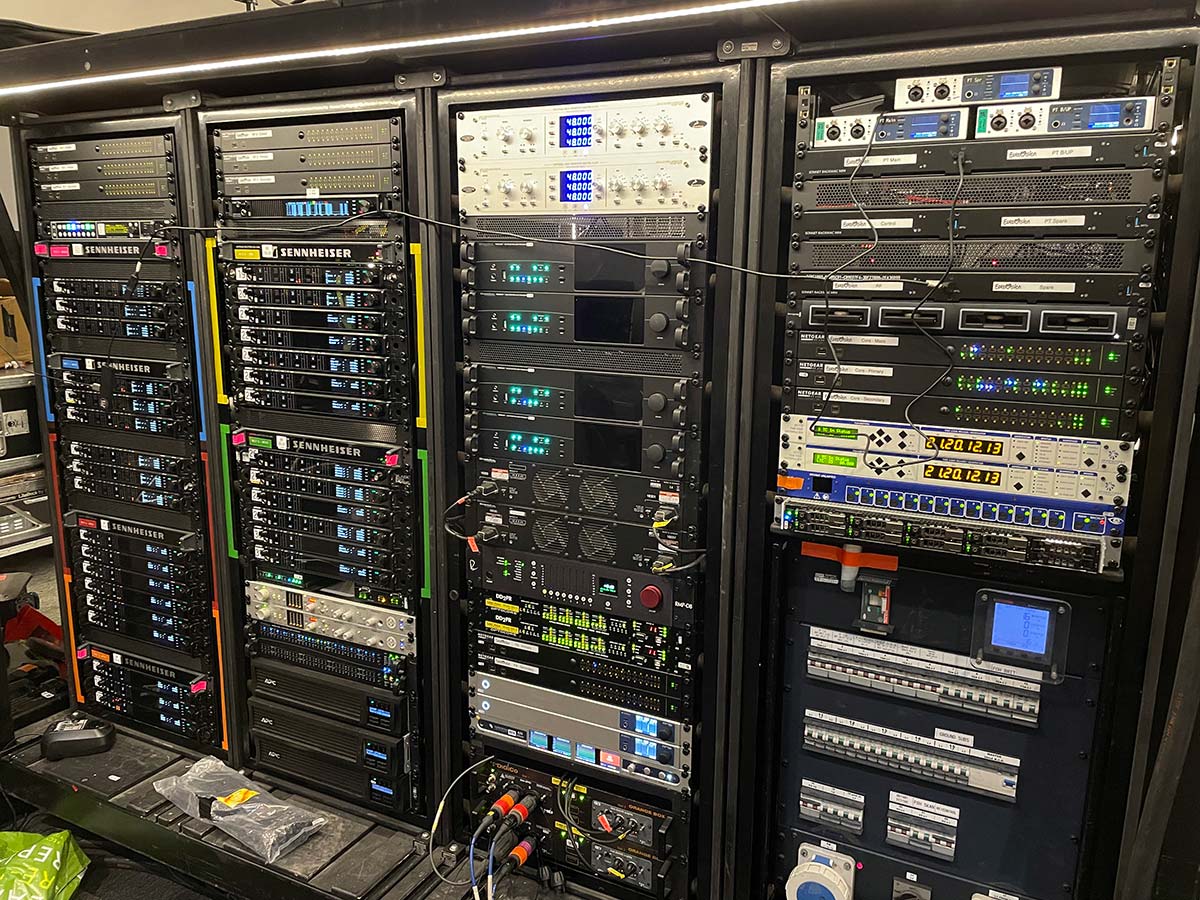 “This is where the Prodigy’s flexibility really came into play,” says Josh. “We can take MADI from one set of consoles and Dante from another, as well as analogue backups from each.
“This is where the Prodigy’s flexibility really came into play,” says Josh. “We can take MADI from one set of consoles and Dante from another, as well as analogue backups from each.
“And then utilising the Prodigy’s input manager, we can have a seamless switchover if we have failure at one of the consoles, or from any other piece of hardware in the signal chain.
“The whole audio network and audio system is synced back to the OB compound, so we’re synchronous with TV – but if we were to lose clock from them for any reason, all of the audio network could kind of freewheel within multiple points within the system.
“So it had the ability to kind of ‘self-heal’, because not only can it auto-switch between clock sources, it also has the FastSRC if it loses sync on an input source – another really nice feature!
“That gave us that resilience that we need, and with minimal human interaction in the case of a failure. That’s really important on a televised project like Eurovision, where you have such a large global audience, as well as the live show in the arena itself. You have to ensure that if there is a problem, the audience isn’t even aware of it, and the switching capabilities of both the Prodigy and M.1K2 enabled us to achieve that.”
“In terms of other DirectOut, we also had Andiamos for some of our conversion. We were taking in things like sound field microphones – providing audience mics in surround format – so that gave us some additional high-end conversion, as well as providing some of the analogue redundancy for the consoles.
“Then we had the EXBOX.BLDS as part of the playback system, which enabled us to switch between computers, and, in the unlikely event of two Prodigys failing, gave us a third layer of redundancy.
“We were also handling all of the audience mics in the arena for broadcast, which were hooked up to mic cards in the Prodigys. So in terms of I/O we were utilising pretty much everything the Prodigy has to offer.
“And then in terms of features, we had DirectOut’s EARs for switching between three playback systems. And the great thing about all of this, is we can monitor all of it from GlobCon.”
About GlobCon
GlobCon is DirectOut’s customisable software platform, providing extensive control for both the Prodigy Series and other DirectOut devices, including the Andiamo, M.1K2 and EXBOX Series.
Specifically designed to support for professional entertainment and live music shows, GlobCon provides extensive management and control for both point-to-point (e.g. MADI) and audio-networked systems (Dante, Ravenna), with access to matrix mixers, summing busses, and effects like EQ, Dynamics and Delay.
Multiple users can share control of devices using a standard Ethernet infrastructure, allowing large audio networks to be monitored from multiple positions within the arena.
“GlobCon was incredibly helpful on Eurovision,” recalls Josh. “It gives you that ability to link directly into endpoints – such as network switches or other audio hardware – which can then be accessed via a web browser.
“We had one audio operator on-site who was tasked solely with monitoring everything on the backbone of the system. And with GlobCon, he had the ability to monitor everything from a single dashboard spread over multiple monitors.
“On top of that, the monitoring and customisation of layouts within GlobCon gives you a kind of ‘high-level overview’ of all the switching, all of the metering, and all of the redundancy systems, all from one page.
“So if the operator wants to delve deeper into a specific area in the Prodigy, maybe a particular routing page, they can do that easily, which as you can image is very helpful in the navigation of a complex audio system.
“This is particularly important to a show like Eurovision, where people may be requesting changes during the rehearsal period. Or you may need to troubleshoot during the build stage, for example figuring out why a signal isn’t arriving where it’s supposed to.”
L-Acoustics, RME, Ferrofish & AVB
The PA system inside the Liverpool Arena was from L-Acoustics, this time based around another digital/AoIP format, AVB (Audio Video Bridging). For conversion between the two worlds, Josh chose a product from another brand he’s relied on many times before.
“There were a huge amount of amplifiers distributed over the fibre network as endpoints, all using AVB, so we had an RME M-1610 Pro as our AVB talker.
“That was key to being able to get that large channel count distributed around the arena. And the great thing with the 1610 is it gives us reliable conversion from MADI to AVB.
“It’s also dual power supply, its MILAN-compliant so it has AVB primary and secondary, and it’s just another really robust product for these kinds of jobs.”
The playback rig also featured four of RME’s MADIface XT interfaces, which Josh says he’s come to swear by.
“Yeah we use a lot of RME at Brit Row,” Josh explains. “They’re another brand that’s incredibly reliable, and they provide really good audio quality.
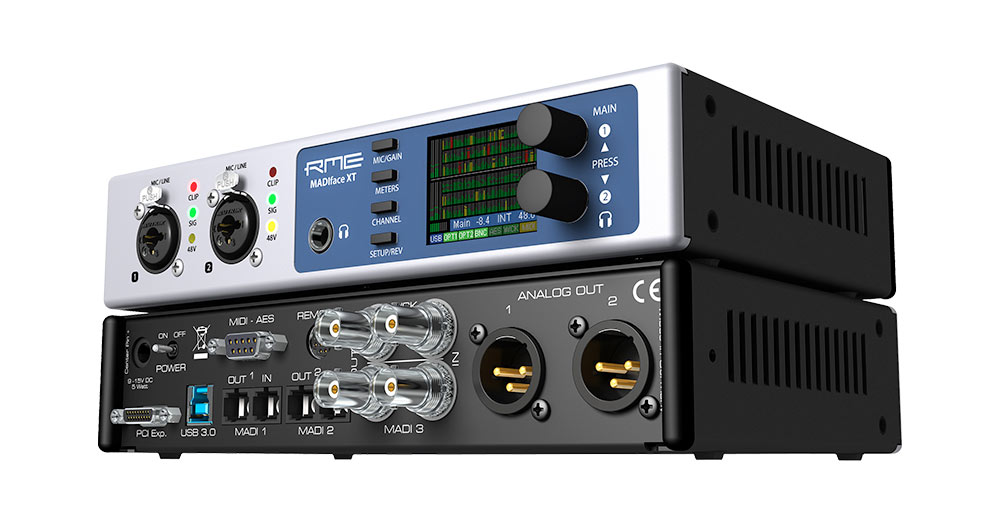 “I personally own a bunch of RME devices – the MADIface XT, along with various MADI Routers and MADI Bridges. I’ve invested personally because I also think they’re great, as does everyone else at Brit Row, and in terms of an audio interface I wouldn’t use anything else.
“I personally own a bunch of RME devices – the MADIface XT, along with various MADI Routers and MADI Bridges. I’ve invested personally because I also think they’re great, as does everyone else at Brit Row, and in terms of an audio interface I wouldn’t use anything else.
“On Eurovision the playback is obviously a large part of the show, so the entire playback system was based around three MADIface XTs, with a fourth one for a rehearsal system.
“You can duplicate the output, so we actually duplicated a 64 channel MADI stream across all three sockets. That enabled us to have three discrete outputs feeding each prodigy, and also our EXBOX.BLDS, so there’s nothing in the middle. That removes the need for any additional hardware providing a split, which would be another potential point of failure.”
“We also had Ferrofish A32s, which we stock a lot of at Britannia Row Productions. They’ve become very popular due to the density of conversion they offer in a 1U format – again, very reliable with dual power supplies, Dante and MADI support, and with a bunch of routing options built in.
“On Eurovision they provided a lot of our redundancy. Anywhere we had network or MADI audio, and needed to give the endpoint the ability to switch between a digital source and an analogue source.
“You can also auto-switch between optical and BNC MADI. So on a project like this where resilience is so important, we can also have two MADI sources running to the A32, and again it’ll switch over if there’s a loss of clock. And then the dual power supplies enable us to run a UPS on one of them, which is another important factor – having that power redundancy.”
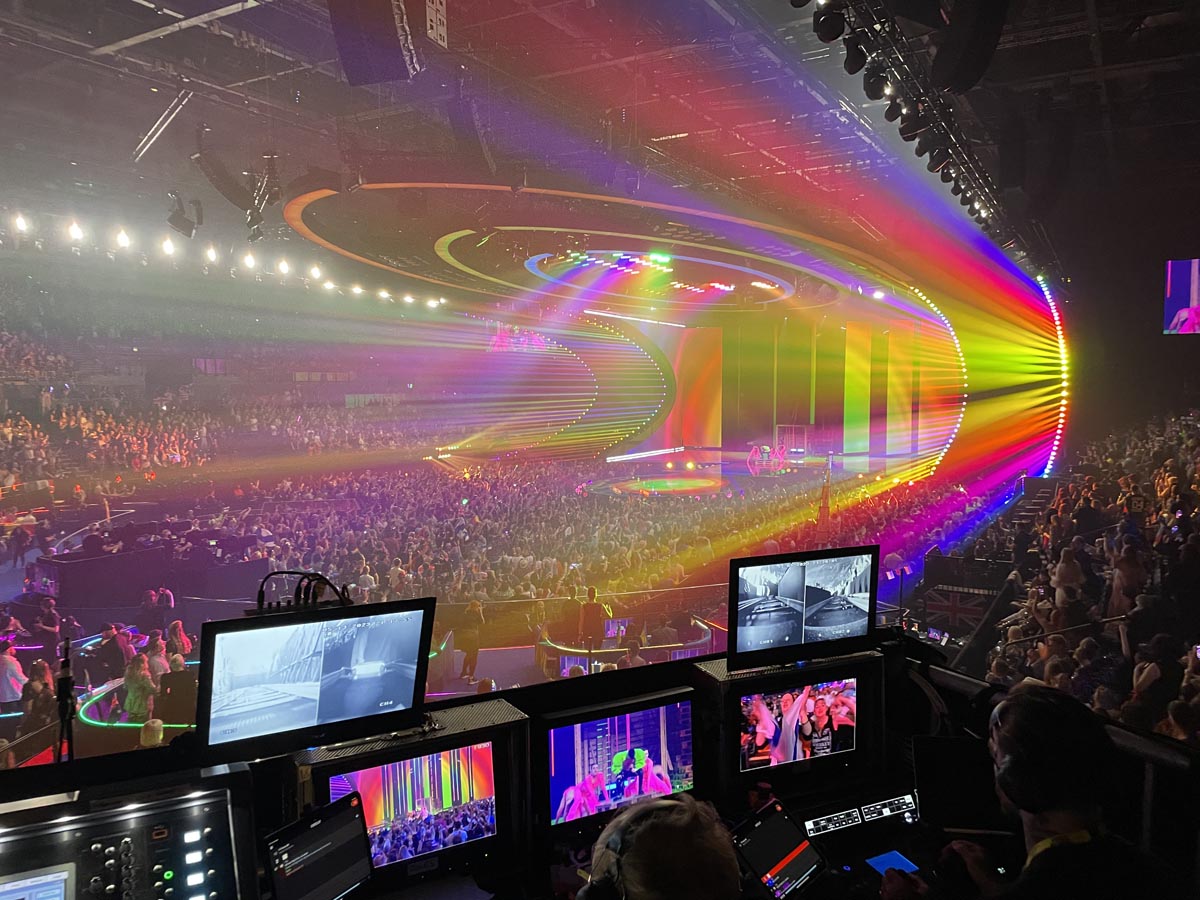 TotalMix FX, Timecode & OSC
TotalMix FX, Timecode & OSC
Eurovision is powered largely in part by automation, with much of the lighting and even some of the camera switching pre-programmed ahead of the event.
The safe delivery of timecode was therefore crucial, along with show control data via RTP Midi.
“Obviously Eurovision is vocal to track, with the candidates or delegates delivering everything ahead of time,” Josh explains of the playback rig. “That’s put onto a Pro Tools system, with playback via the MADIfaces XTs, which are also providing timecode out.
“The whole show is driven by timecode, so it’s distributed all over our audio network. It’s responsible for a lot of the lighting and a lot of the video graphics, as well as the automation of pieces of the sets, so it’s really important to the smooth delivery of the show.
“Many of the moving elements in the lighting rigs, as well as the camera cutting and vision mixing on Eurovision, is automated and triggered using a system called CuePilot. So timecode is a really key element to the look of the show, and why the production looks so slick and very high-end.
“The other great thing for us is that TotalMix supports OSC (Open Sound Control protocol). We had a lot of OSC going on, for controlling both the Prodigys and other pieces of hardware on the network, and TotalMix was part of that.
“We were able to create some incredibly complex macros – using StreamDeck from Elgato, and a piece of software called Companion – enabling us to create sequences of events which could be triggered from a single button press.
“And the ability to use OSC with both GlobCon and TotalMix was key to be able to do that, and key to the overall success of the project.”
“you very rarely hear of a piece of RME hardware going wrong”
A recurring theme with RME users, Josh cites the long-term support of RME products as a key consideration in their choice for ‘mission-critical’ applications like TV events and live music tours, as well as the legendary reliability that has made RME so popular with professional audio engineers.
“One last thing I should mention is RME’s long-term support, and the reliability of their drivers,” Josh says to wrap things up. “RME are one of the few brands that always have drivers for new operating systems available straight away – whenever Apple bring out a new OS, they’re always first to the table.
“That’s the reason for using them on a show like this – that reliability and robustness of their drivers – and the fact that you very rarely hear of a piece of RME hardware going wrong.”
Massive thanks to Josh Lloyd and Britannia Row Productions for taking the time to help us with this article. To find out more about Britannia Row Productions, visit; www.britanniarow.com






















